Most users manage the absence notifications themselves via Outlook. Before a planned absence, such as vacation, the user enters the desired message and, if necessary, specifies a deputy. In addition, the helpdesk or a user's line manager should usually also be able to enter an absence notification for users; this is usually useful for unplanned absences, for example in the event of illness.
How the company implements the absence notifications is usually very different. Some rely on PowerShell scripts, some use an Identity Manager with approval processes. There are various ways to achieve this.
One of these ways is the free tool "Out of Office Manager" from CodeTwo. The Out of Office Manager is particularly suitable for smaller companies or for the helpdesk.
As I have already had a few inquiries about scripts and the like, I would like to briefly introduce the tool. As already mentioned, it is free to use and can be installed with just a few clicks.
For this short article, I installed the "Out of Office Manager" on a client PC (as is usually done in the HelpDesk).
After installation, the connection to the on-prem Exchange Server or Office 365 is briefly configured:
The connection can be configured either directly with Autodiscover or manually:
A user with the appropriate rights is required to create out-of-office messages. A separate account with impersonation authorization can be created so that an admin user does not have to be specified here.
You can find instructions on how to do this here:
Create RBAC-compliant account for CodeTwo Software
I have created the "OOOManager" account for this purpose:
In the last step, the connection to Exchange / Office 365 can be tested:
After configuration, the absence notifications can be clearly managed.
In my case, the health mailboxes of the Exchange Server are also displayed here, as I have not specified a corresponding scope for the OOFManager account:
The absence notification can now be created by selecting the relevant area and clicking the "Add" button. As you can see here, you can use ready-made or your own templates. Dynamic data such as "Start", "End", "First/last name", "Department" and many other data can be read from the Active Directory and used within the template. Here is a simple template:
With the "Recurrence" option, absence messages can be entered on a recurring basis (useful for part-time employees, for example):
The templates can be created with the "Template Editor" and various variables can also be used:
In the settings, you can also specify how often a notification should be sent to the sender. By default, Exchange sends one notification per sender every 24 hours. Other intervals can also be set using the Out of Office Manager:
Once an entry has been saved, the duration of the absence is clearly displayed:
My personal conclusion: Very well thought-out and clear tool. You can usually do without your own PowerShell scripts here.
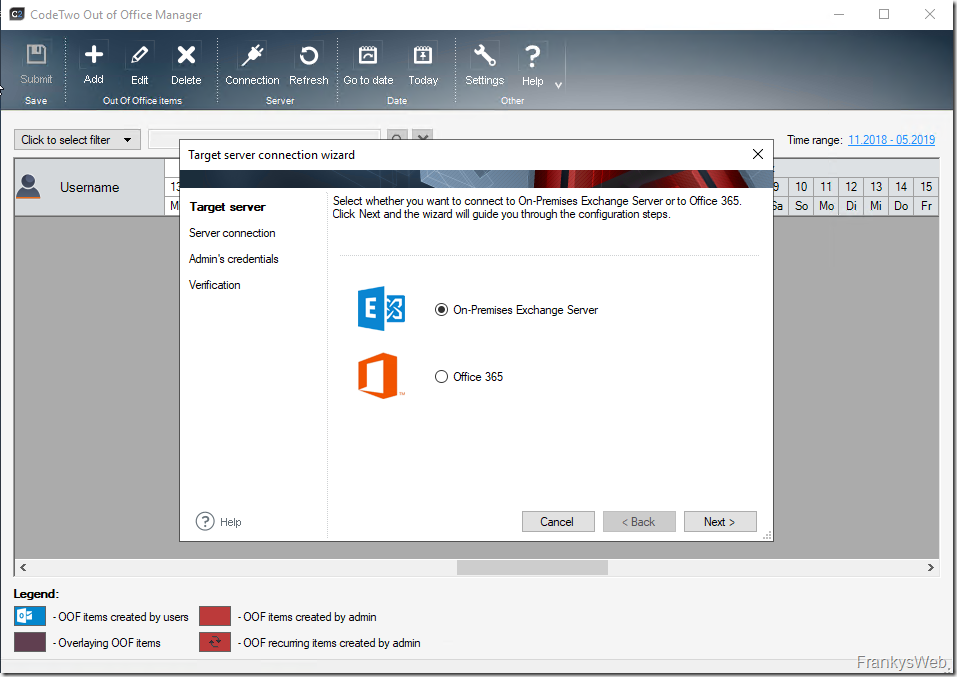
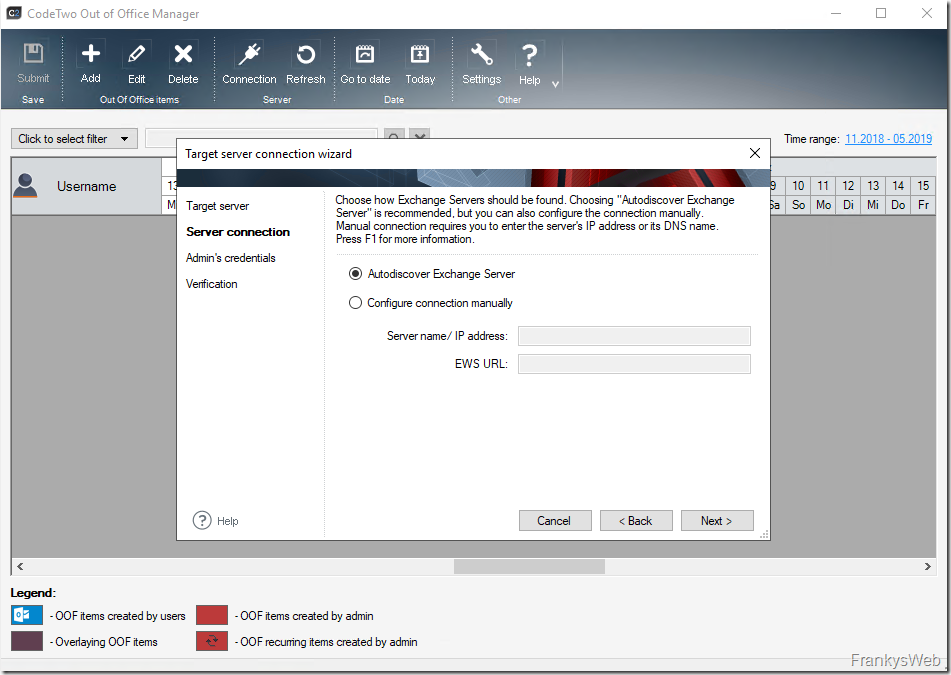
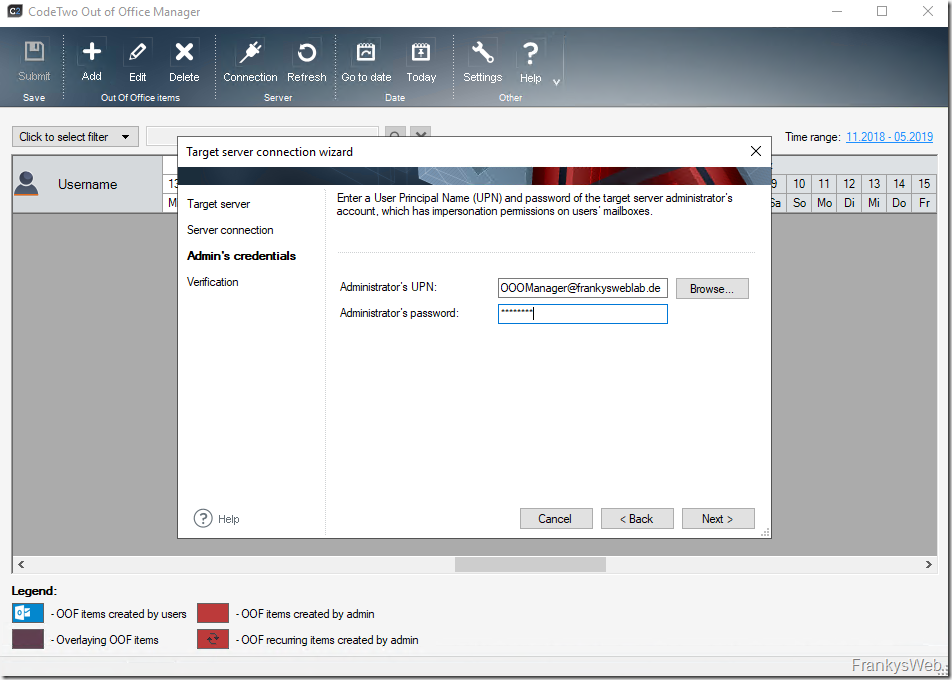
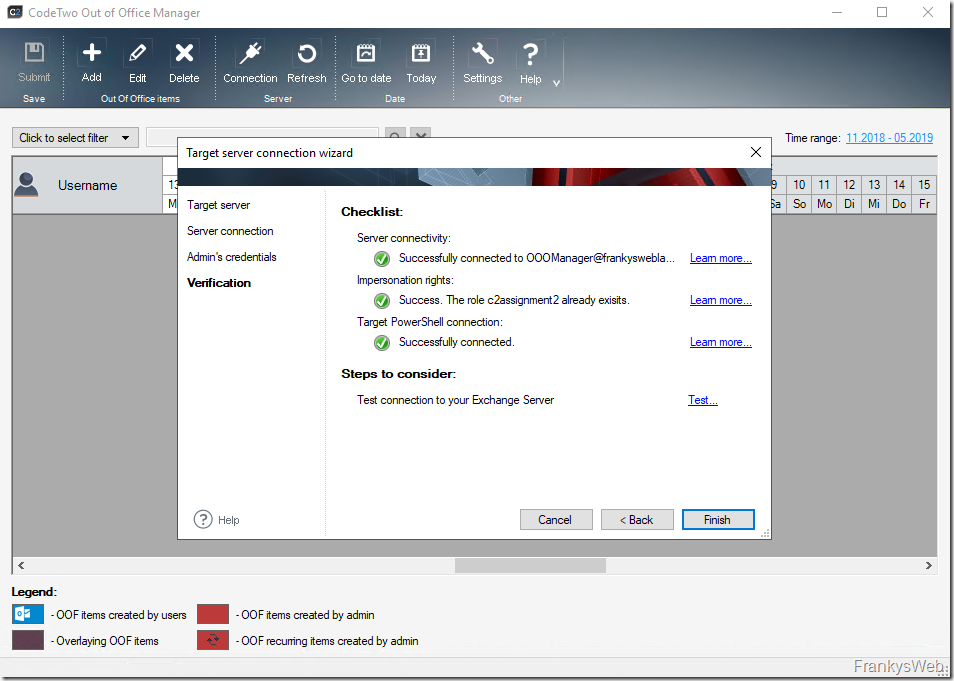
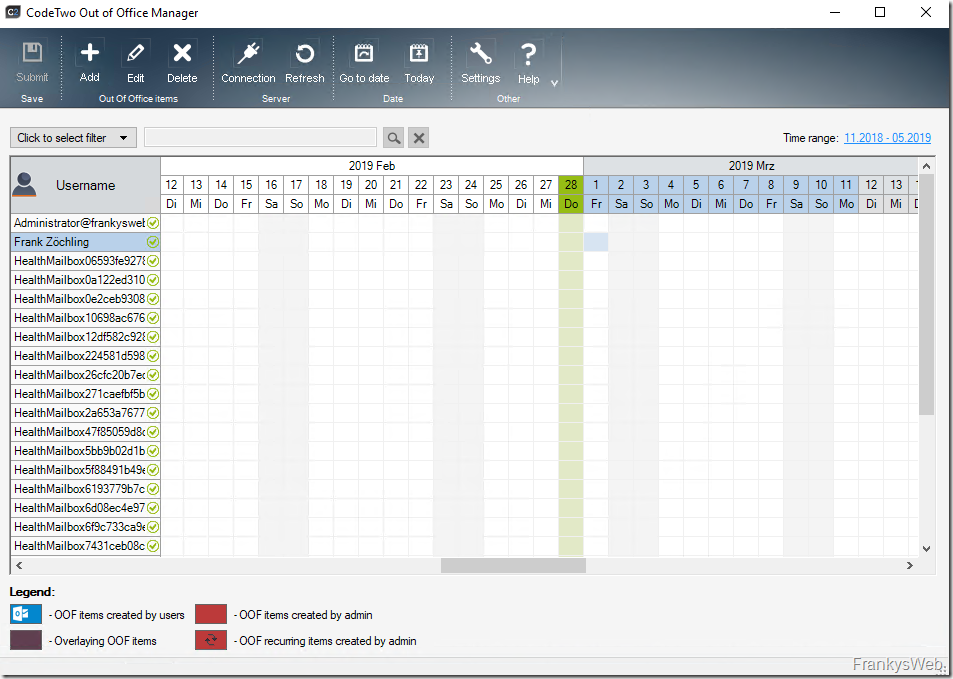
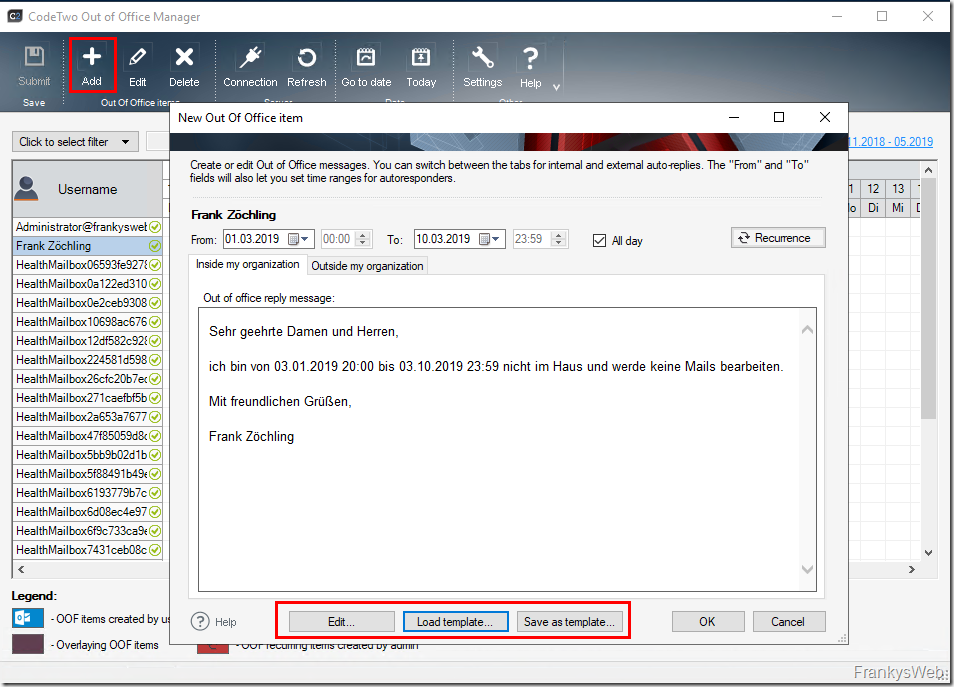
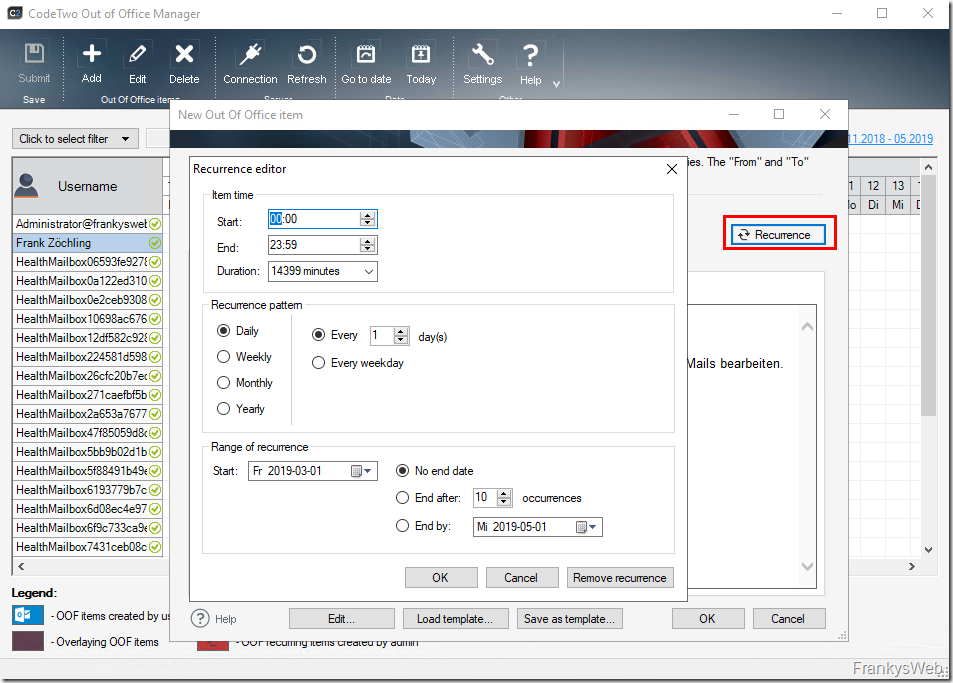
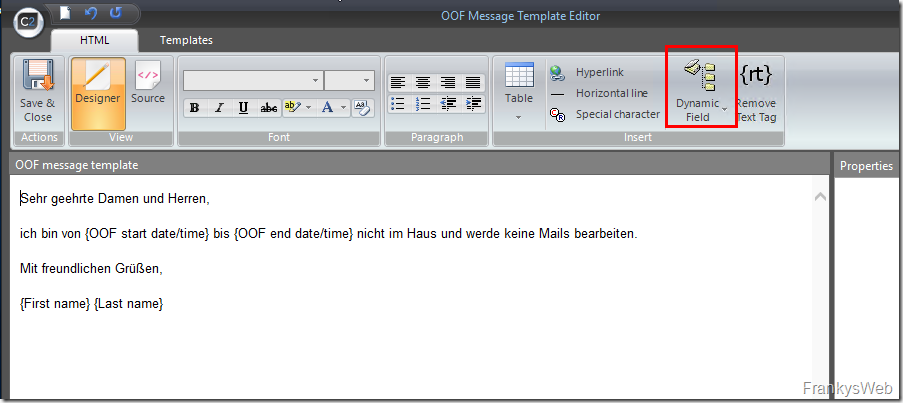
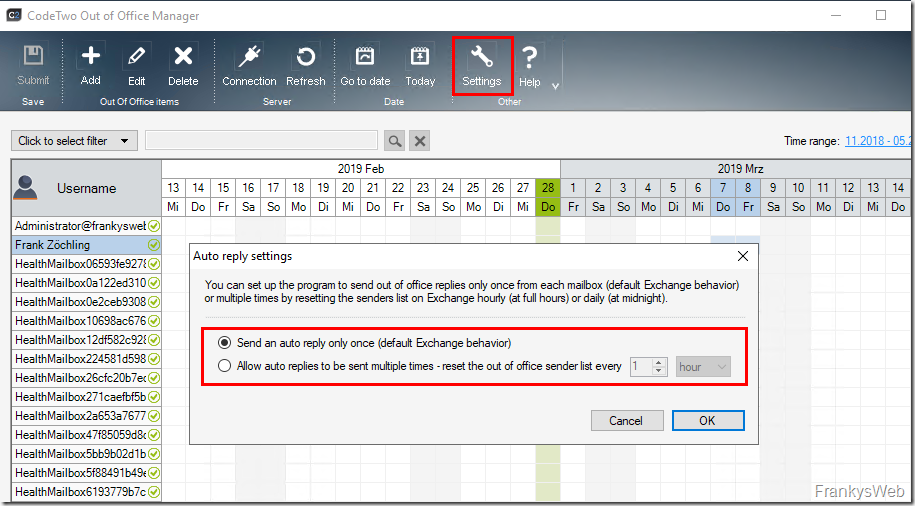
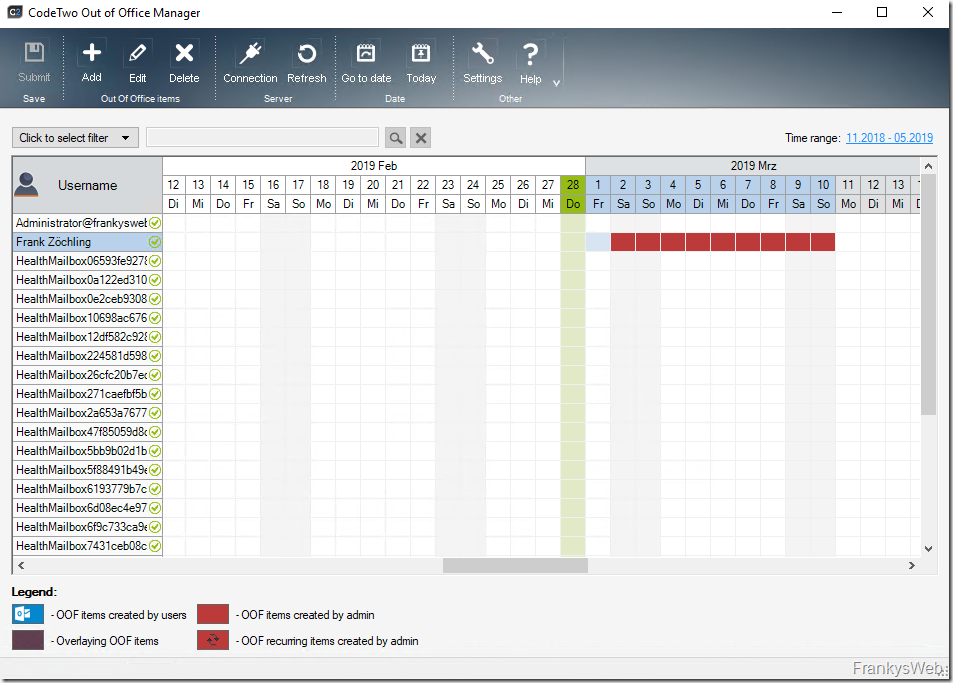

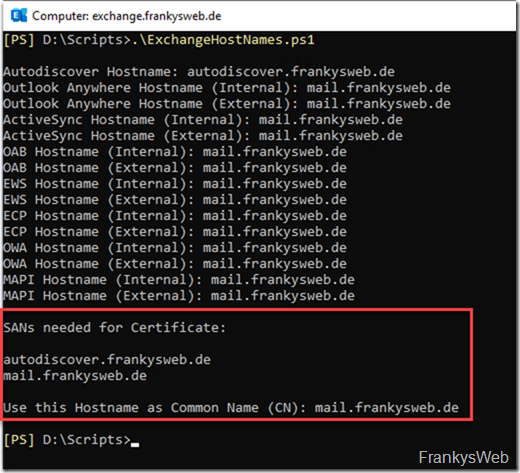

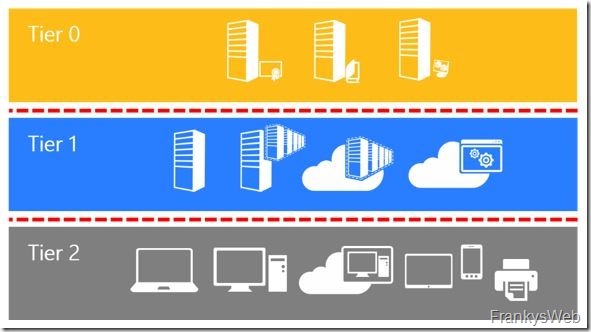

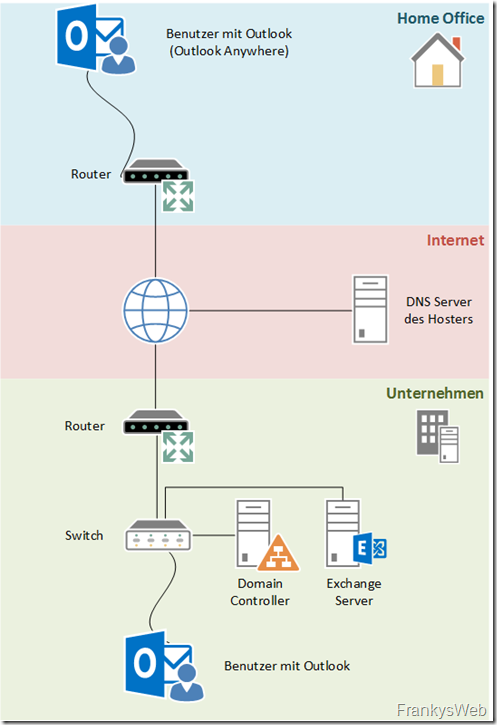
Programm wurde von CodeTwo um den 24.9.2019 eingestellt. Siehe: https://www.codetwo.com/kb/oom-useful-links/?_ga=2.17242032.821252352.1573043729-558885111.1544514842
Hallo,
hatte mich schon eingeschoßen, aber dann…
Datumsformat auf Deutsch ist im Text falsch, sieht man auch im oberen Screenshot, mm.dd.yyyy statt dd.mm.yyyy.
Hab bisher nichts gefunden zum ändern….
Hatte das gleiche Problem,
Hier ein link zum lösen des Problems:
https://www.codetwo.com/kb/date-time-format/
Man muss in einem Template auf dem Platzhalter gehen das Datumsformat unter properties ändern (z.B. dd.MM.yyyy) und das Template neu abspeichern.
Ich erhalte immer wieder die Meldung bei Impersonation Rights/Powershell connection:
Beim Verbinden mit dem Remoteserver „outlook.exchange.local“ ist folgender Fehler aufgetreten: Benutzername oder Kennwort ist falsch […]
Der Benutzer ist ein Service Nutzer
Der Benutzer kann sich mit dem Server connecten.
Der Benutzer hat das ApplicationImpersonation Recht
Auf dem Clients läuft die EWS 2.2.
Danke für den schönen Artikel, aber hat das Tool schon mal jemand in einer Umgebung (OnPrem) mit 3000+ Mailboxen ausprobiert.
Mehr als ein Loading über mehrere Tage und keine Ansichten der Mailboxen bekomme ich nicht.
Checkliste alles grün…
Leider somit für mich nicht nutzbar.
So gehts uns auch – in einer größeren Umgebung wird einfach gar nichts angezeigt. CodeTwo supported das Produkt nicht mehr – daher eigentlich nutzlos.
Wir verwenden das sehr gute und zuverlässige Produkt von CI-Solution. https://www.ci-solution.com/
Zu erwähnen wäre auch noch vom gleichen Anbieter MailPolicy. Hier können sogar alle mobilen Geräte in eine zentrale OoO-Konfiguration eingebunden werden. Inkl. Werbetext, etc. Einfach zu bedienen und zu konfigurieren. Kann ich sehr empfehlen.
Wir verwenden https://www.ci-solution.com/produkte/oof-abwesenheitsassistent.html. Wir setzen es in einer Hybridumgebung ein. Wegen EXO und OnPrem muss man in einer bestimmten Konstellationen auf das direkten Umleiten von E-Mails verzichten aber ich sehe hier das Problem bei Microsoft. Wir können das Produkt somit empfehlen.
Hallo zusammen,
Achtung bei dem Programm.. Das war früher kostenpflichtig jedoch hat es mit neuren Exchange Versionen plötzlich aufgehört verlässlich zu funktionieren. Bei uns wurden z.b. die OOF Meldungen zwar in der CodeTwo GUI angezeigt wenn man diese auf mehreren Usern aktiviert hatte, jedoch angewendet wurde es effektiv nur beim ersten.
WIr haben dann den support kontaktiert und plötzlich war das Produkt nicht mehr kostenpflichtig und es gab offiziell keinen Support mehr.. Aus meiner Sicht haben die Probleme mit der EWS API bekommen, habs aber nie im Detail rausgefunden. Ist aber schon alles ziemlich strange..
Also bevor ihr euch mit zuviel Hoffnung drauf stürzt, vorher gut testen. Ist am Ende schwierig den Usern dann zu erklären wieso es plötzlich nicht mehr funktioniert…
Falls jemand ein alternatives Programm kennt gerne her damit, wir sind immer noch auf der Suche ;)
Lg
Simon
Danke Frank für den Post. Genau das Tool, das fehlt, um z. B. Mitarbeitern der Personalabteilung ein schalten von Abwesenheitsnachrichten z. B. im Krankheitsfall einfach zu ermöglichen.